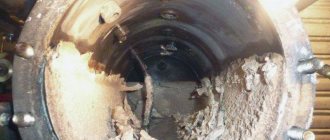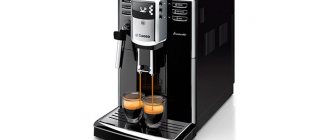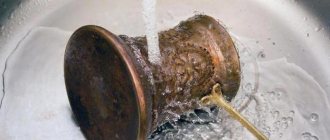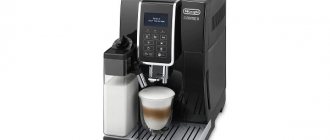Agree, it’s nice to pamper yourself in the morning and throughout the day with a cup of thick, aromatic coffee brewed in a coffee machine! However, after a long period of operation, particles of coffee powder may remain in the machine, scale from the water gradually accumulates, and bacteria begin to multiply in the remaining milk foam in the cappuccino maker and an unpleasant odor appears.
If your coffee tastes musty, it means your coffee machine needs cleaning. The manufacturer recommends cleaning regularly. Read the article about how to do this correctly.
Why descale your coffee machine?
The composition of clean, tasty water includes certain minerals and trace elements: calcium, magnesium, ferrous, potassium, chloride compounds. When heated, they form a limescale deposit, which gets into the coffee as white flakes and makes it tasteless, and ultimately threatens corrosion of the internal elements. The surface of the scale is porous, and microorganisms and bacteria quickly begin to multiply in it.
The maximum amount of plaque is formed by calcium dissolved in an aqueous environment, so the process of descaling a coffee machine is often called decalcification.
You can determine when it’s time to descale your coffee machine by the following signs:
- The smell of coffee changed, it became unpleasant and musty;
- The coffee is not strong enough or under-brewed;
- The steam pressure dropped noticeably;
- The sound of the coffee machine has changed.
Some coffee machines have automatic limescale check sensors. A flashing red indicator or message on the panel informs the user that it is time to decalcify.
How often should you descale?
To know when and how to descale your coffee machine with citric acid, you should consider several factors. The frequency between descaling cycles depends on two main points:
- The level of calcium and magnesium salts present in the water (depending on the area where you live).
- Number of cups of coffee prepared.
Most modern coffee machines are equipped with indicators that indicate the descaling time. In this case, you just need to carry out the cleaning procedure.
If the equipment does not have such a function, calcified formations should be removed at least once every two months or after 200-300 cups of brewed drink, regardless of whether brewing water or frothed milk is used.
Why is it worth descaling your coffee machine with citric acid?
Many manufacturers produce special cleaning products for their coffee machines. They can be purchased at large chain stores of household appliances or ordered online. There are specific formulations for coffee machines from Bosh, Saeco, Delonghi and other brands, as well as universal cleaners, liquid or tablets.
We do not recommend using universal products or products from other brands to avoid damaging the internal surfaces of the coffee machine.
Never descale your coffee machine with bathroom or kitchen descalers or kitchen detergents!
The best universal remedy that is guaranteed to be suitable for any coffee machine is citric acid.
- Absolutely harmless to human health;
- Effectively copes even with old scale;
- Does not form toxic fumes when heated;
- 100% environmentally friendly;
- Much cheaper than branded cleaners;
- Sold in all stores and always at hand.
Instructions for descaling different types of coffee makers
The method for descaling a coffee maker depends on the design of the device. Machines with a removable filter and brewing unit can be easily washed under the tap in running water. If you regularly wash the device after making coffee, then thorough cleaning with citric acid or store-bought tablets can be done no more than once a month.
Models with a built-in unit often have an auto-cleaning (decalcification) function, and if it is not provided, the scale is removed independently using a cleaning solution.
Most modern products are based on citric acid.
How to descale a coffee machine with citric acid?
On average, the cleaning process takes about 30-45 minutes. Old deposits may require more time or a repeat cleaning cycle.
- Unplug the coffee machine.
- Take out the water container, rinse it under running water, and fill it with the prepared solution of the required volume for your coffee machine model. Proportions - 25-30 grams of citric acid per liter of water.
- Place the water container in the coffee machine and plug in the device.
- For coffee machines with automatic cleaning function. Just run this function.
- For coffee machines without automatic cleaning. Wait 15-20 minutes and start the coffee brewing process without adding coffee. Repeat as many times as needed to use up all the citric acid solution.
- Turn off the coffee machine. Remove and rinse the water container with running water. Make sure it is clean, if not, clean again. If yes, we move on to washing.
- Fill the container with as much clean water as possible and turn on the drink preparation mode. Use up the water.
- Repeat step 7 one more time.
After cleaning and two rinses, your coffee machine will be free of limescale.
Cleaning should be done quarterly or after every 250 cups of coffee. Focus on the water hardness in your region.
Citric acid is an effective household remedy for removing scale.
The quality and speed of cleaning the coffee machine directly depends on the chosen anti-scale agent. In this case, experts recommend using citric acid according to the following scheme:
- dilute 30 grams of cleanser in a liter of water;
- pour the resulting solution into the water container on the body of the coffee machine and activate the “Espresso” button;
- wait 3-4 hours;
- then we start the coffee preparation program again;
- We complete the cleaning procedure by repeatedly rinsing the unit with warm water.
If there was too much scale in the coffee maker, it makes sense to repeat the procedure for cleaning the kitchen appliance again. No citric acid? No problem. You can clean your coffee maker using freshly squeezed lemon juice:
- cut 2-3 medium lemons in half;
- take gauze and squeeze lemon juice through it;
- We clean the resulting juice from pulp and particles and dilute it in a liter of water.
Proportions for preparing a solution of citric acid
A cleaning solution of citric acid for descaling a coffee machine is prepared in the proportion of 30 g of the substance per 1 liter of clean water. Considering that a standard sachet of citric acid contains 10 g of powder, you will need 3 sachets. In this case, adjustments must be made for the volume of the water tank of a particular model.
We suggest you read: How to clean a washing machine from scale with vinegar
The recommended concentration of citric acid should not be exceeded. A solution that is too caustic will damage the device components. It is especially harmful for parts made of plastic and light metal alloys.
Descaling a drip coffee maker
- Wash the filter with warm water and a soft brush (unnecessary toothbrush) and return it to its place.
- Prepare a working liquid from citric acid: dissolve 30 g of crystalline powder in 4 glasses of warm water.
- Pour the solution into the water tank. Add cold water to the tank up to the Max mark.
- Turn on the coffee maker for 5-10 minutes. After 30 minutes, repeat the procedure and wait until the entire solution passes into the receiving flask.
- If there are still traces of scale on the filter, dip it in a hot solution prepared in the indicated way and hold for an hour.
- Rinse the filter well and replace it.
- Run clean water through the coffee maker several times until the acid comes out completely.
We suggest you familiarize yourself with how to remove resin from a car body yourself.
Citric acid can be replaced with vinegar. To do this, use white table vinegar with a strength of 9%, dissolved in water in a ratio of 1:2.
If the glass vessel for collecting the finished coffee becomes cloudy, you need to fill it with a warm solution and rinse thoroughly after 30 minutes with water.
Auto cleanup
Cleaning the coffee machine programmed by the manufacturer is a convenient function. This means that the user simply needs to follow the steps described in the instructions. And if it states that it is necessary to use a certain product, then it should be purchased. The cleaning process will take no more than 5 minutes, and if everything is done correctly, then there will be no trace of scale left.
It is useful to run the coffee machine decalcification program regularly, and if possible, even daily. Setting an automatic program is possible for a certain time, for example, at night. Such preventive cleaning will help to avoid the initial accumulation of scale, and therefore eliminate serious problems with the unit.
Before starting the auto-cleaning process, you should check the supply of decalcifier, if it is also supplied independently from a special cartridge in the housing.
Attention! It is worth understanding that this function is not available in all models of coffee machines, but only in quite expensive ones, so in most cases you will have to clean it yourself.
Action plan for most standard coffee machines with auto-clean function:
- Rinsing the water tank, removing grains.
- Pouring the product (pre-prepared solution) into the tank.
- Launch the auto-clean function.
- Rinsing the tank and hopper of the coffee machine with a stream of water.
- Start the cooking program. The first portion should be poured out.
Cleaning tablets
Using special tablets, cleaning is carried out as efficiently as possible. They are pre-dissolved in water in certain proportions (more details can be found on the packaging). 1 tablet is used for 1 cleaning session. Cleaning tablets can be produced:
- From scale.
- To remove coffee oils.
Let us remind you once again that they are not interchangeable and are used for specific purposes. On sale you can find branded (more expensive) and universal ones. What you choose is up to you, but experts do not recommend saving on cleaning products for expensive coffee machines.
Causes of scale formation
Many people assume that scale is formed due to the fact that low-quality water is used, but this is an incorrect assumption. Pure, filtered water contains many microelements such as calcium, potassium, magnesium, chloride, and iron. When heated, their compounds form a limescale deposit, which is familiar to everyone. If you do not systematically descale the coffee machine, this “disease” will progress, forming corrosion of the internal parts of the machine. In addition, the porous texture of scale is an ideal environment for the development of bacteria.
Many modern devices have built-in scale control sensors, but if the model does not have this function, then there are several ways to check whether it’s time to descale. Firstly, the taste of your usual coffee changes. Secondly, the smell of the drink takes on a musty tinge. Third, you will notice a decrease in steam pressure. Fourthly, the strength of the drink will decrease and, finally, the coffee machine will begin to make unusual noises during operation.
How much citric acid to use to clean a coffee machine?
If you haven’t cleaned the device for a long time, as a result of which a fairly impressive layer of scale has formed, dissolve 3-4 teaspoons of acid (heaped) in one liter of water. If cleaning is carried out regularly: every time a message appears on the display about the need for decalcification, then 2 teaspoons per liter of water is enough.
Why shouldn’t you take more than 4 tablespoons of the product? The fact is that the standard washing program in a coffee machine does not always remove the taste of acid used in large quantities. Although some machines produced today do this rinsing through a hot water spout, so even if the machine is not completely rinsed, there should be no aftertaste in the coffee.
Descaling tablets
A special composition of tablets will allow you to descale your coffee machine: sulfamic and maleic acids, a corrosion inhibitor and baking soda. They are used to remove scale that forms in the internal water channels of the device, clogging them and contributing to the destruction of rubber and plastic parts.
The following inscriptions are placed on the packages:
- for decalcification;
- descaling;
- CALC;
- Descaling;
- Decalcifier.
https://www.youtube.com/watch?v=vaEveK7QmL4
When choosing a tablet, focus on the brand of the coffee machine. For example, a tablet of this particular brand will be suitable for a KRURS coffee machine. Cleaning capsules are produced for capsule coffee makers.
On a note! If the machine has a reservoir for ground coffee, place the tablet there after filling the reservoir with clean water.
General instructions for using tablets:
- Dissolve the tablet in clean water.
- Pour the resulting solution into the coffee machine reservoir up to the internal MAX line.
- Select the black coffee function.
- When the cup is half full, turn off the device for 15 minutes.
- Turn on the machine again to release the second half of the liquid.
- Clean the brewing unit.
- Repeat brewing twice without the tablet.
Special means
Before descaling your coffee maker, you should decide what exactly to use for cleaning. Almost every major manufacturer of coffee machines offers their own branded products. Most often they are advised to buy them together with a coffee machine. It is safe to use a special product for a coffee machine, but many doubt how safe they are for humans.
The product must be prepared in a special way. It is not difficult to make the solution according to the instructions; it is in the instruction manual for the device itself and on the decalcifier. You cannot violate the proportions, otherwise you can harm both the device and your own health. You can make liquids for cleaning a coffee machine yourself, but before using them you should carefully read the algorithm.
Attention! If you need to prepare the product, you should use only clean water for dissolution, the same as for making coffee.
If you need to clean coffee oils, then the descaling agent will not cope with this; you need special tablets. The filter of the coffee machine and the entire brewing unit, on which oils and coffee particles are firmly deposited, require cleaning from time to time to remove coffee oils. Failure to do so may lead to clogging of the drain valve and subsequent repair of the device. There are also models with and without automatic filter cleaning.
Attention! The descaling program and the coffee oil cleaning program are two different types of cleaning and therefore require different products.











